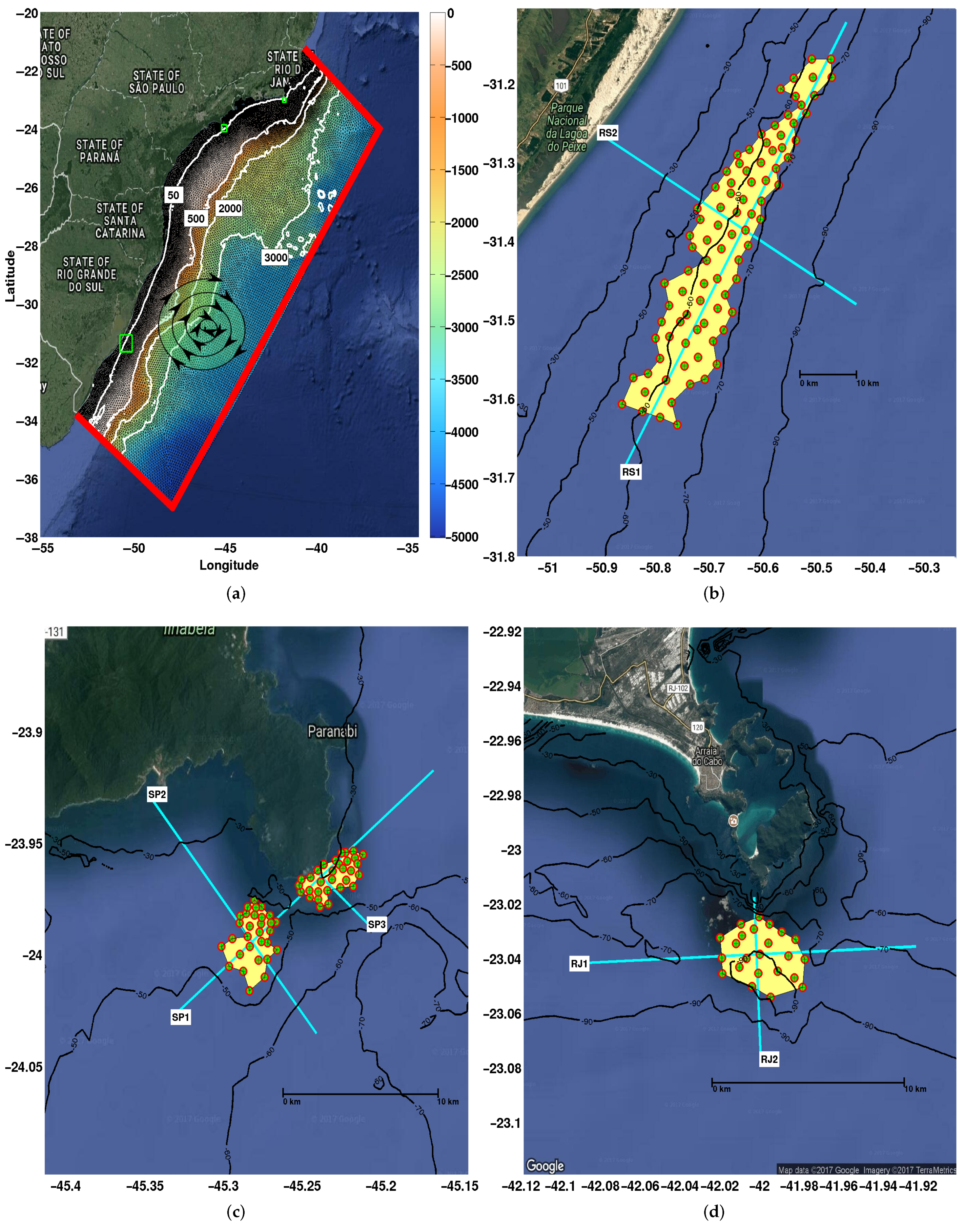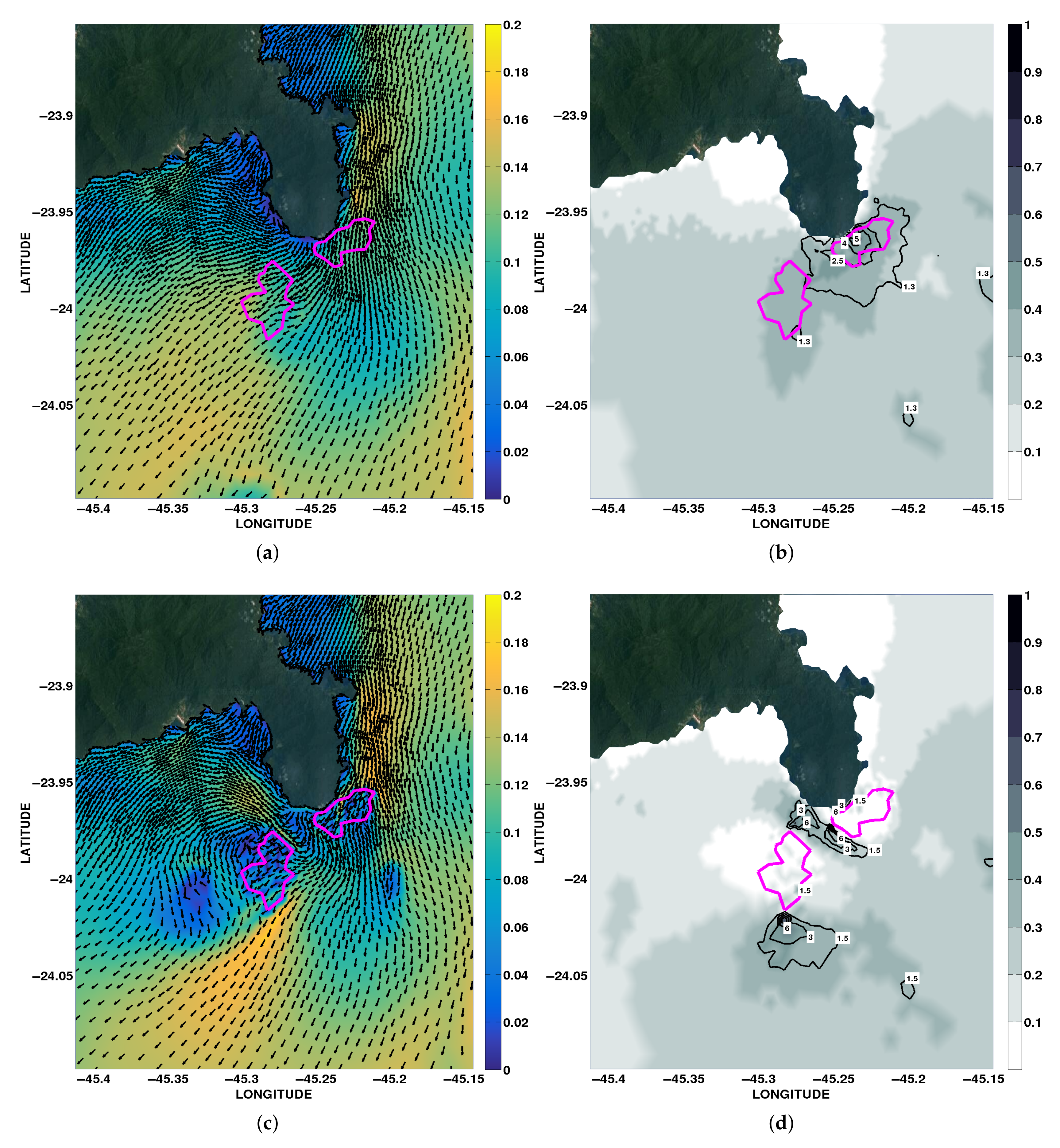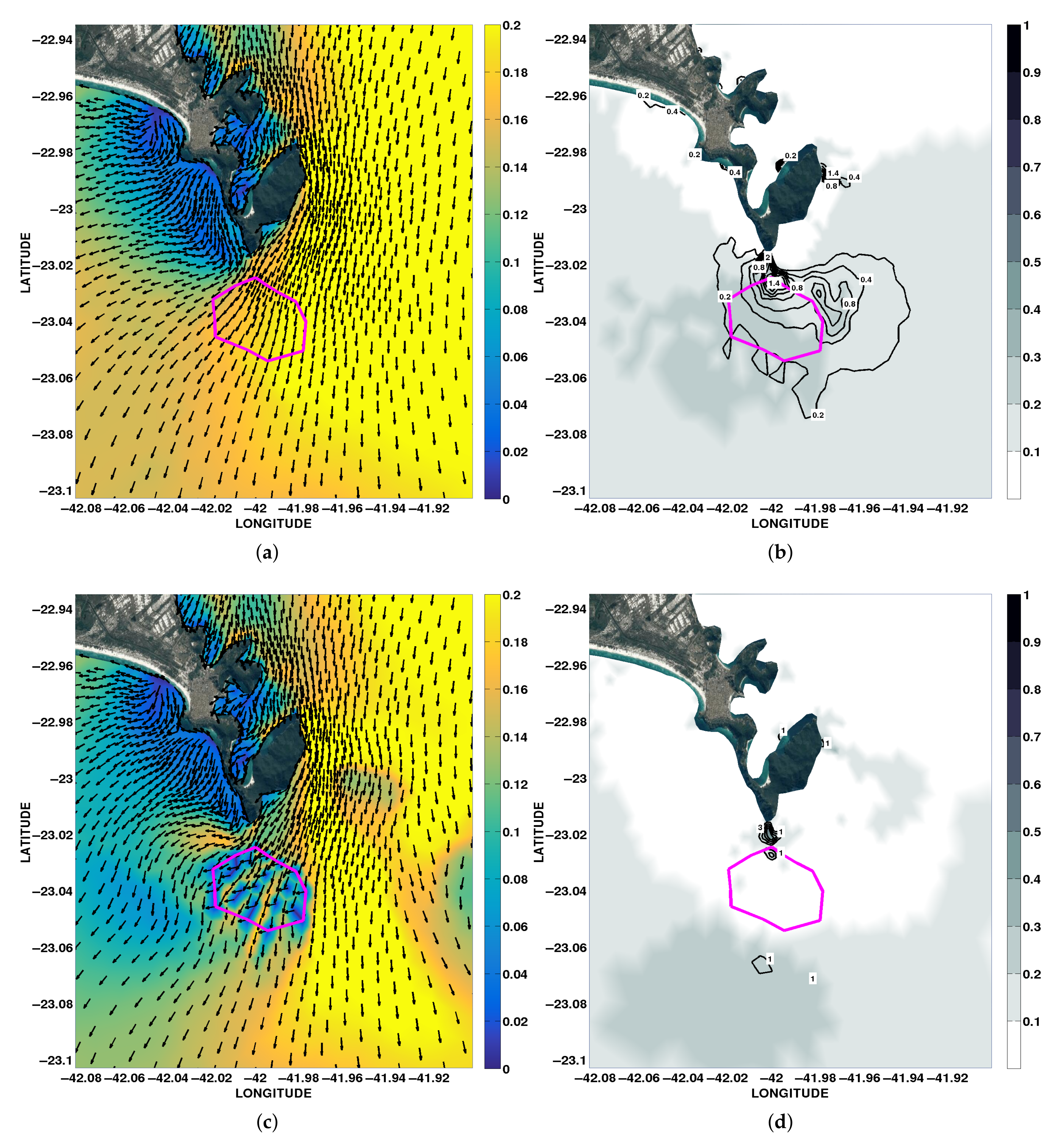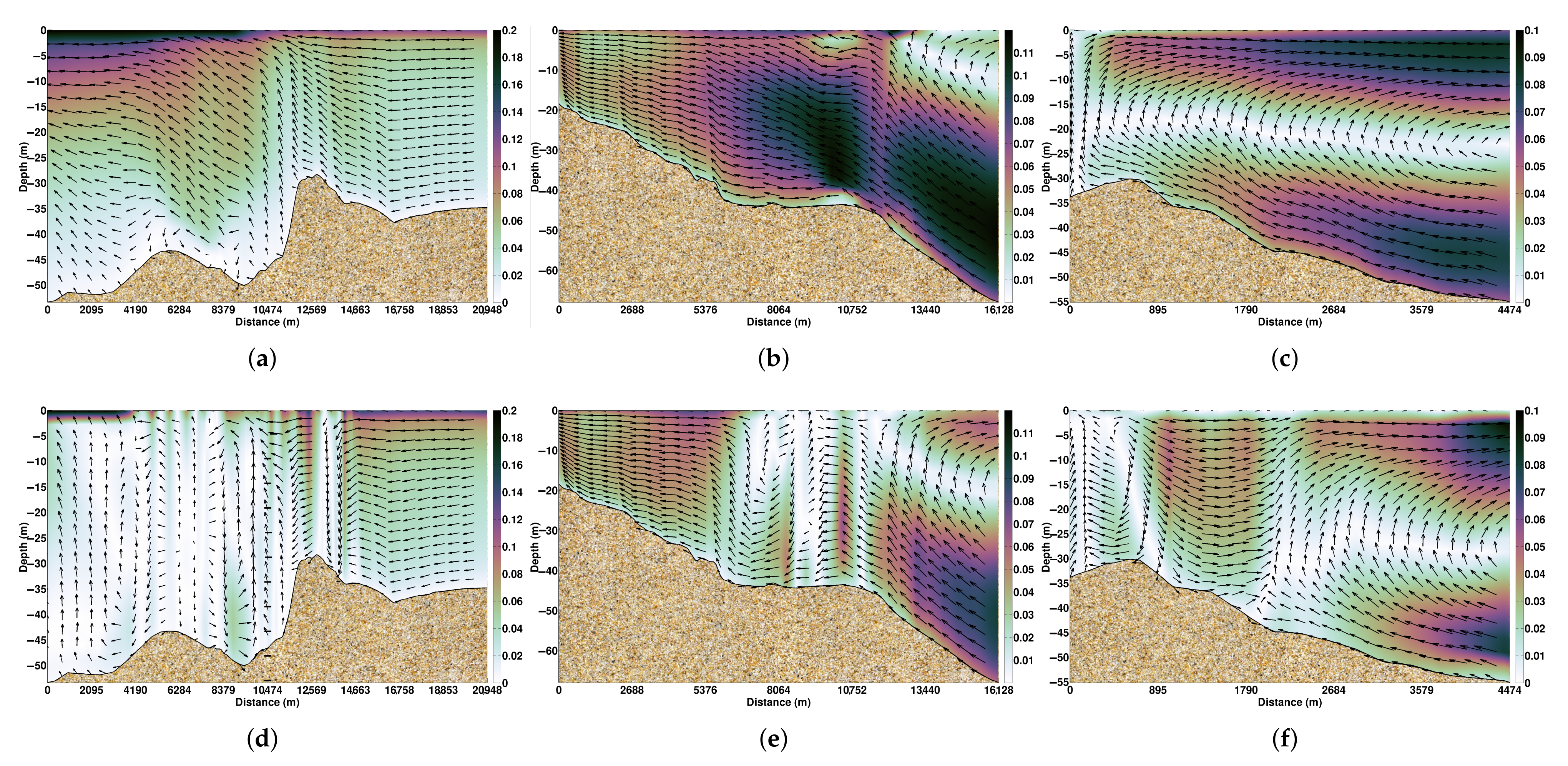Hydrodynamic and Morphodynamic Influences from Ocean Current Energy Conversion Sites in the South–Southeastern Brazilian Inner Shelf
Abstract
:1. Introduction
2. Materials and Methods
2.1. Simulation Setup
2.2. Defining Energy Conversion Sites
- Bathymetry ranging from 30 to 90 m;
- The distance from the coast is imperative in reducing cabling costs, rendering the project feasible;
- A frequency analysis was performed to select zones with current velocity up to 0.30 m·s;
- Regarding the frontal and lateral distance among turbines is imperative for increasing farm power conversion. These distances vary with the incident flow, according to Myers and Bahaj [28]. The lateral turbulent effect is able to reach 3 diameters of distance from the turbine, while the frontal turbulence varies from 6 to 10 times in diameter [29].
2.3. Initial and Boundary Conditions
3. Results and Discussion
3.1. Turbine Farm Performance
3.2. Environmental Impacts
4. Conclusions
- Rio Grande do Sul turbines farm: The greatest site studied with 440 km of area, accounting for 87 turbines.
- The extracted power from this site on average was 45.30 kW·day, reaching a maximum power output of 539 kW·day produced during the entire period 16.55 MW.
- The RS site presented noteworthy morphodynamical changes due to the presence of turbines. The bed shear stress was reduced to almost zero in the entire site due to surface velocity depletion. Allied with bed shear stress reduction, two zones of deposition across the borders of the site appeared.
- São Paulo turbines farm: within an area of 13.78 km, 61 turbines were defined.
- The mean power obtained from this site was 22.94 kW·day, reaching maximum power output of 237.47 kW·day and generating 8.38 MW over 10 years.
- The presence of the turbines caused drastic changes in the mean surface hydrodynamics. This affected considerably the morphodynamic processes, such as increased bedload rates southeast of São Sebastião Island. Bed shear stress changed to almost zero values inside the turbine sites.
- Rio de Janeiro turbines farm: 23 marine turbines were set inside a 10 km region.
- For this farm, the average power was 6.75 kW·day reaching maximum power output of 258.09 kW·day and producing almost 2.47 MW during the entire simulation.
- The turbines caused disturbances in the mean surface velocity, which generated wake street patterns downstream and also a bifurcation/divergence in the current’s core direction. This impacted the bottom behavior as well. A major decrease in bed shear stress promoted an accumulation of bedload in the south and north of the site near the coastline.
Supplementary Materials
Author Contributions
Funding
Institutional Review Board Statement
Informed Consent Statement
Data Availability Statement
Acknowledgments
Conflicts of Interest
References
- Copping, A.; Sather, N.; Hanna, L.; Whiting, J.; Zydlewski, G.; Staines, G.; Gill, A.; Hutchison, I.; O’hagan, A.M.; Simas, T.; et al. Annex IV 2016 State of the Science Report: Environmental Effects of Marine Renewable Energy Development Around the World; Technical Report; Implementing Agreement on Ocean Energy Systems: Paris, France, 2016. [Google Scholar]
- Ng, K.W.; Lam, W.H.; Ng, K.C. 2002–2012: 10 Years of Research Progress in Horizontal-Axis Marine Current Turbines. Energies 2013, 6, 1497–1526. [Google Scholar] [CrossRef] [Green Version]
- Finkl, C.W.; Charlier, R. Electrical power generation from ocean currents in the Straits of Florida: Some environmental considerations. Renew. Sustain. Energy Rev. 2009, 13, 2597–2604. [Google Scholar] [CrossRef]
- Marques, W.C.; Fernandes, E.H.L.; Malcherek, A.; Rocha, L.A.O. Energy converting structures in the Southern Brazilian Shelf: Energy Conversion and its influence on the hydrodynamic and morphodynamic processes. J. Earth Sci. Geotech. Eng. 2012, 1, 61–85. [Google Scholar]
- Akimoto, H.; Tanaka, K.; Uzawa, K. A conceptual study of floating axis water current turbine for low-cost energy capturing from river, tide and ocean currents. Renew. Energy 2013, 57, 283–288. [Google Scholar] [CrossRef]
- Yang, X.; Haas, K.A.; Fritz, H.M. Evaluating the potential for energy extraction from turbines in the gulf stream system. Renew. Energy 2014, 72, 12–21. [Google Scholar] [CrossRef] [Green Version]
- Goundar, J.N.; Ahmed, M.R. Marine current energy resource assessment and design of a marine current turbine for Fiji. Renew. Energy 2014, 65, 14–22. [Google Scholar] [CrossRef]
- Kirinus, E.D.P.; Marques, W.C.; Jung, B.M.; Stringari, C.E.; Matzenauer, H.B. Evaluating current power availability for energy conversion along the Southern Brazilian Shelf. Int. J. Mar. Energy 2015, 10, 97–112. [Google Scholar] [CrossRef]
- Kirinus, E.D.P.; Marques, W.C. Viability of the application of marine current power generators in the south Brazilian shelf. Appl. Energy 2015, 155, 23–34. [Google Scholar] [CrossRef]
- Shirasawa, K.; Tokunaga, K.; Iwashita, H.; Shintake, T. Experimental verification of a floating ocean-current turbine with a single rotor for use in Kuroshio currents. Renew. Energy 2016, 91, 189–195. [Google Scholar] [CrossRef]
- Tseng, R.S.; Chang, Y.C.; Chu, P.C. Use of Global Satellite Altimeter and Drifter Data for Ocean Current Resource Characterization. In Marine Energy Renewable: Resource Characterization and Physical Effects, 1st ed.; Yang, Z., Copping, A., Eds.; Springer: Seattle, WA, USA, 2017; Chapter 7; pp. 159–177. [Google Scholar]
- Kirinus, E.D.P.; Oleinik, P.H.; Costi, J.; Marques, W.C. Long-term simulations for ocean energy off the Brazilian coast. Energy 2018, 163, 364–382. [Google Scholar] [CrossRef]
- Bane, J.M.; He, R.; Muglia, M.; Lowcher, C.F.; Gong, Y.; Haines, S.M. Marine Hydrokinetic Energy from Western Boundary Currents. Annu. Rev. Mar. Sci. 2017, 9, 105–123. [Google Scholar] [CrossRef] [PubMed] [Green Version]
- Bryden, H.L.; Beal, L.M.; Duncan, L.M. Structure and Transport of the Agulhas Current and Its Temporal Variability. J. Oceanogr. 2005, 61, 479–492. [Google Scholar] [CrossRef]
- Halkin, D.; Rossby, T. The Structure and Transport of the Gulf Stream at 73° W. J. Phys. Oceanogr. 1985, 15, 1439–1452. [Google Scholar] [CrossRef] [Green Version]
- Leaman, K.D.; Molinari, R.L.; Vertes, P.S. Structure and Variability of the Florida Current at 27° N: April 1982–July 1984. J. Phys. Oceanogr. 1987, 17, 565–583. [Google Scholar] [CrossRef] [Green Version]
- Zhu, X.H.; Kaneko, A.; Saito, T.; Gohda, N. Kuroshio Stream path variation and its associated velocity structures south of Shikoku, Japan. Geophys. Res. Lett. 2001, 28, 4615–4618. [Google Scholar] [CrossRef]
- VanZwieten, J.H.; Duerr, A.E.S.; Alsenas, G.M.; Hanson, H.P. Global ocean current energy assessment: An initial look. In Proceedings of the 1st Marine Energy Technology Symposium (METS13) Hosted by the 6th Annual Global Marine Renewable Energy Conference, Washington, DC, USA, 15–17 April 2013. [Google Scholar]
- Dottori, M.; Castro, B.M. The response of the Sao Paulo Continental Shelf, Brazil, to synoptic winds. Ocean Dyn. 2009, 59, 603–614. [Google Scholar] [CrossRef]
- Castro, B.M. Summer/winter stratification variability in the central part of the South Brazil Bight. Cont. Shelf Res. 2014, 89, 15–23. [Google Scholar] [CrossRef]
- De Souza, R.B.; Robinson, I.S. Lagrangian and satellite observations of the Brazilian Coastal Current. Cont. Shelf Res. 2004, 24, 241–262. [Google Scholar] [CrossRef]
- Möller, O.O.J.; Piola, A.R.; Freitas, A.C.; Campos, E.J.D. The effects of river discharge and seasonal winds on the shelf off southeastern South America. Cont. Shelf Res. 2008, 28, 1607–1624. [Google Scholar] [CrossRef]
- Hervouet, J.M. Free Surface Flows: Modelling with the Finite Element Methods; Wiley & Sons: Chichester, UK, 2007. [Google Scholar]
- Pham, C.T.; Joly, A. Telemac Modelling System: Telemac-3D Software—Operating Manual; Technical Report; EDF: Chateau, France, 2016. [Google Scholar]
- Tassi, P.; Villaret, C. Sisyphe v6.3 User’s Manual; Technical Report; EDF: Chateau, France, 2014. [Google Scholar]
- Gorlov, A. Tidal Energy. In Elements of Physical Oceanography: A Derivative of the Encyclopedia of Ocean; Academic Press: Cambridge, MA, USA, 2001; pp. 2955–2960. [Google Scholar] [CrossRef]
- Cornett, A.M. A Global Wave Energy Resource Assessment. In Proceedings of the Eighteenth International Offshore and Polar Engineering Conference, Vancouver, BC, Canada, 6–11 July 2008; Volume 8, p. 9. [Google Scholar]
- Myers, L.; Bahaj, A.S. Simulated electrical power potential harnessed by marine current turbine arrays in the Alderney Race. Renew. Energy 2005, 30, 1713–1731. [Google Scholar] [CrossRef]
- Giles, J.; Myers, L.; Bahaj, A.; Shelmerdine, B. The dowstream wake response of marine current energy converters operating in shallow tidal flows. In World Renewable Energy Congress; Marine and Ocean Technology: Linköping, Sweden, 2011; pp. 2270–2277. [Google Scholar]
- Myers, L.E.; Bahaj, A.S. An experimental investigation simulating flow effects in first generation marine current energy converter arrays. Renew. Energy 2012, 37, 28–36. [Google Scholar] [CrossRef] [Green Version]
- Cummings, J.; Carroll, S. Software User’s Manual for the Navy Coupled Ocean Data Assimilation (NCODA) System; Technical Report; Naval Research Laboratory: Monterey, CA, USA, 2006. [Google Scholar]
- Pham, C.T.; Lyard, F. Use of tidal harmonic constants databases to force open boundary conditions in TELEMAC. In XIX TELEMAC-MASCARET User Conference; Bourban, S., Durand, N., Hervouet, J.M., Eds.; HR Wallingford: Oxford, UK, 2012; pp. 165–172. [Google Scholar]
- Egbert, G.D.; Erofeeva, S.Y. Efficient Inverse Modeling of Barotropic Ocean Tides. Am. Meteorol. Soc. 2002, 19, 183–204. [Google Scholar] [CrossRef] [Green Version]
- Soares, I.D.; Kourafalou, V.; Lee, T.N. Circulation on the western South Atlantic continental shelf: 2. Spring and autumn realistic simulations. J. Geophys. Res. 2007, 112, C04003. [Google Scholar] [CrossRef]
- Cerda, C.; Castro, B.M. Hydrographic climatology of South Brazil Bight shelf waters between Sao Sebastiao (24° S) and Cabo Sao Tome (22° S). Cont. Shelf Res. 2014, 89, 5–14. [Google Scholar] [CrossRef]
- Da Silveira, I.C.A.; Schmidt, A.C.K.; Campos, E.J.D.; de Godoi, S.S.; Ikeda, Y. A corrente do Brasil ao largo da costa leste brasileira. Rev. Bras. Oceanogr. 2000, 48, 171–183. [Google Scholar] [CrossRef]
- EPE. Balanço Energético Nacional 2017: Ano Base 2016; Technical Report; Empresa de Pesquisa Energética: Rio de Janeiro, Brazil, 2017. [Google Scholar]
- Hagerman, G.; Polagye, B.; Bedard, R.; Previsic, B. Methodology for Estimating Tidal Current Energy Resources and Power Production by Tidal in-Stream Energy Conversion (TISEC) Devices; Technical Report; Rep. EPRI-TP-001 NA Rev 2; Electric Power Research Institute: Palo Alto, CA, USA, 2006. [Google Scholar]
- Ortega-Achury, S.L.; McAnally, W.H.; Davis, T.E.; Martin, J.L. Hydrokinetic Power Review; Technical Report; Bagley College of Engineering: Starkville, MS, USA, 2010. [Google Scholar]
- Torrence, C.; Compo, G.P. A practical guide to wavelet analysis. Bull. Am. Meteorol. Soc. 1998, 79, 61–78. [Google Scholar] [CrossRef] [Green Version]
- Liu, Y.; Liang, X.S.; Weisberg, R.H. Rectification of the bias in the wavelet power spectrum. J. Atmos. Ocean. Technol. 2007, 24, 2093–2102. [Google Scholar] [CrossRef]
- Toldo, E.J.; Almeida, L.; Dillenburg, S.; Tabajara, L.; Borghetti, C. Parâmetros MorfodinâMicos e Deriva Litorânea da Praia de Tramandaí—RS. Geosul 1993, 8, 75–88. [Google Scholar]
- Soares, I.D.; Kourafalou, V.; Lee, T.N. Circulation on the western South Atlantic continental shelf: 1. Numerical process studies on buoyancy. J. Geophys. Res. 2007, 112, C04002. [Google Scholar] [CrossRef] [Green Version]
- Marques, W.C.; Fernandes, E.H.; Monteiro, I.O.; Möller, O.O. Numerical modeling of the Patos Lagoon coastal plume, Brazil. Cont. Shelf Res. 2009, 29, 556–571. [Google Scholar] [CrossRef]
- Parise, C.K.; Calliari, L.J.; Krusche, N. Extreme Storm Surges in the South of Brazil: Atmospheric Conditions and Shore Erosion. Braz. J. Oceanogr. 2009, 57, 175–188. [Google Scholar] [CrossRef]
- Marques, W.C.; Fernandes, E.H.L.; Moller, O.O. Straining and advection contributions to the mixing process of the Patos Lagoon coastal plume, Brazil. J. Geophys. Res. 2010, 115, C06019. [Google Scholar] [CrossRef] [Green Version]
- Marques, W.C.; Fernandes, E.H.L.; Moraes, B.C.; Möller, O.O.; Malcherek, A. Dynamics of the Patos Lagoon coastal plume and its contribution to the deposition pattern of the southern Brazilian inner shelf. J. Geophys. Res. Ocean. 2010, 115, C10045. [Google Scholar] [CrossRef]
- Costa, R.L.; Moller, O.O. Study of the structure and variability of currents in the area of the inner shelf off Rio Grande (RS, Brazil), southwest of the South Atlantic during spring-summer 2006–2007. J. Integr. Coast. Zone Manag. 2011, 11, 273–281. [Google Scholar] [CrossRef]
- Marques, W.C. The temporal variability of the freshwater discharge and water levels at the Patos Lagoon, Brazil. Int. J. Geosci. 2012, 3, 22456. [Google Scholar] [CrossRef] [Green Version]
- Andrade, M.; Toldo, E.J.; Nunes, J.C. Variabilidade das correntes na plataforma interna ao largo de Tramandaí, RS durante o verão de 2014. Pesqui. Geociências 2016, 43, 289–298. [Google Scholar] [CrossRef]
- Pereira, M.D.; Schettini, C.A.F.; Omachi, C.Y. Caracterização de feições oceanográficas na plataforma de Santa Catarina através de imagens orbitais. Rev. Bras. Geofísica 2009, 27, 81–93. [Google Scholar] [CrossRef]
- Truccolo, E.C. Assessment of the wind behavior in the northern coast of Santa Catarina. Rev. Bras. Meteorol. 2011, 26, 451–460. [Google Scholar] [CrossRef]
- Stech, J.L.; Lorenzzetti, J.A. The response of the South Brazil Bight to the passage of wintertime cold fronts. J. Geophys. Res. 1992, 97, 9507. [Google Scholar] [CrossRef] [Green Version]
- Castro, B.M.; Lee, T.N. Wind-forced sea level variability on the southeast Brazilian shelf. J. Geophys. Res. 1995, 100, 16045. [Google Scholar] [CrossRef]
- Castelao, R.M.; Barth, J.A. Upwelling around Cabo Frio, Brazil: The importance of wind stress curl. Geophys. Res. Lett. 2006, 33, L03602. [Google Scholar] [CrossRef]
- Castro, B.M.; Lorenzzetti, J.A.; da Silveira, I.C.A.; de Miranda, L.B. Estrutura termohalina e circulação na região entre o Cabo de São Tomé (RJ) e o Chuí (RS). In O Ambiente Oceanográfico da Plataforma Continental e do Talude na Região Sudeste-sul do Brasil; Rossi-Wongtschowski, C.L.D.B., Madureira, L.S., Eds.; Edusp: São Paulo, Brazil, 2006; Chapter 1; pp. 11–120. [Google Scholar]
- Palma, E.D.; Matano, R.P. Disentangling the upwelling mechanisms of the South Brazil Bight. Cont. Shelf Res. 2009, 29, 1525–1534. [Google Scholar] [CrossRef]
- Matano, R.P.; Palma, E.D.; Piola, A.R. The influence of the Brazil and Malvinas Currents on the Southwestern Atlantic Shelf circulation. Ocean Sci. 2010, 6, 983–995. [Google Scholar] [CrossRef] [Green Version]
- Swisher, J.N.; Jannuzz, G.S.D.M.; Redlinger, R.Y. Tools and Methods for Integrated Resource Planning: Improving Energy Efficiency and Protecting the Environment; United Nations Environmental Programme: Nairobi, Kenya, 1997. [Google Scholar]
- EMEC. Environmental Impact Assessment (EIA) Guidance for Developers at the European Marine Energy Centre; European Marine Energy Centre: Stromness, UK, 2005; p. 22. [Google Scholar]
- Dolman, S.; Simmonds, M. Towards best environmental practice for cetacean conservation in developing Scotland’s marine renewable energy. Mar. Policy 2010, 34, 1021–1027. [Google Scholar] [CrossRef]
- Shields, M.A.; Woolf, D.K.; Grist, E.P.M.; Kerr, S.A.; Jackson, A.C.; Harris, R.E.; Bell, M.C.; Beharie, R.; Want, A.; Osalusi, E.; et al. Marine renewable energy: The ecological implications of altering the hydrodynamics of the marine environment. Ocean Coast. Manag. 2011, 54, 2–9. [Google Scholar] [CrossRef]
- Vennell, R. Estimating the power potential of tidal currents and the impact of power extraction on flow speeds. Renew. Energy 2011, 36, 3558–3565. [Google Scholar] [CrossRef]
- Fallon, D.; Hartnett, M.; Olbert, A.; Nash, S. The effects of array configuration on the hydro-environmental impacts of tidal turbines. Renew. Energy 2014, 64, 10–25. [Google Scholar] [CrossRef] [Green Version]
- Zembruscki, S.G. Geomorfologia da Margem Continental sul Brasileira e Das Bacias Oceânicas Adjacentes; Technical report; Projeto REMAC: Rio de Janeiro, Brazil, 1979. [Google Scholar]
- De Mahiques, M.M.; Sousa, S.H.D.M.E.; Furtado, V.V.; Tessler, M.G.; Toledo, F.A.D.L.; Burone, L.; Figueira, R.C.L.; Klein, D.A.; Martins, C.C.; Alves, D.P.V. The Southern Brazilian shelf: General characteristics, quaternary evolution and sediment distribution. Braz. J. Oceanogr. 2010, 58, 25–34. [Google Scholar] [CrossRef]
- Nagai, R.; Ferreira, P.; Mulkherjee, S.; Martins, M.; Figueira, R.; Sousa, S.; Mahiques, M. Hydrodynamic controls on the distribution of surface sediments from the southeast South American continental shelf between 23°S and 38°S. Cont. Shelf Res. 2014, 89, 51–60. [Google Scholar] [CrossRef]
- Michaelovitch de Mahiques, M.; Almeida da Silveira, I.C.; de Mello e Sousa, S.H.; Rodrigues, M. Post-LGM sedimentation on the outer shelf–upper slope of the northernmost part of the São Paulo Bight, southeastern Brazil. Mar. Geol. 2002, 181, 387–400. [Google Scholar] [CrossRef]
- De Mahiques, M.M.; Mishima, Y.; Rodrigues, M. Characteristics of the sedimentary organic matter on the inner and middle continental shelf between Guanabara Bay and São Francisco do Sul, southeastern Brazilian margin. Cont. Shelf Res. 1999, 19, 775–798. [Google Scholar] [CrossRef]
- Stramma, L.; England, M. On the water masses and mean circulation of the South Atlantic Ocean. J. Geophys. Res. Ocean. 1999, 104, 20863–20883. [Google Scholar] [CrossRef]
- Campos, E.J.D.; Velhote, D.; da Silveira, I.C.A. Shelf break upwelling driven by Brazil current cyclonic meanders. Geophys. Res. Lett. 2000, 27, 751–754. [Google Scholar] [CrossRef]
- Marques, W.C.; Stringari, C.E.; Eidt, R.T. The Exchange Processes of the Patos Lagoon Estuary – Brazil: A Typical El Niño Year versus a Normal Meteorological Conditions Year. Adv. Water Resour. Prot. 2014, 2, 11–20. [Google Scholar]
- McCave, I. Erosion and deposition by currents on submarines slopes. Bull. L’Institut Géologie Bassin D’Aquitaine 1982, 31, 47–55. [Google Scholar]
- Franco-Fraguas, P.; Burone, L.; Mahiques, M.; Ortega, L.; Urien, C.; Muñoz, A.; López, G.; Marin, Y.; Carranza, A.; Lahuerta, N.; et al. Hydrodynamic and geomorphological controls on surface sedimentation at the Subtropical Shelf Front / Brazil–Malvinas Confluence transition off Uruguay (Southwestern Atlantic Continental Margin). Mar. Geol. 2014, 349, 24–36. [Google Scholar] [CrossRef]
- Neill, S.P.; Robins, P.E.; Fairley, I. The Impact of Marine Renewable Energy Extraction on Sediment Dynamics. In Marine Energy Renewable: Resource Characterization and Physical Effects2, 1st ed.; Yang, Z., Copping, A., Eds.; Springer: Seattle, WA, USA, 2017; Chapter 12; pp. 279–304. [Google Scholar]
- Ahmadian, R.; Falconer, R.A. Assessment of array shape of tidal stream turbines on hydro-environmental impacts and power output. Renew. Energy 2012, 44, 318–327. [Google Scholar] [CrossRef]
- Ross, L.; Sottolichio, A.; Huybrechts, N.; Brunet, P. Tidal turbines in the estuarine environment: From identifying optimal location to environmental impact. Renew. Energy 2021, 169, 700–713. [Google Scholar] [CrossRef]
- Ramírez-Mendoza, R.; Amoudry, L.; Thorne, P.; Cooke, R.; Simmons, S.; McLelland, S.; Murphey, B.; Parsons, D.; Jordan, L.; Vybulkova, L. Impact of Scaled Tidal Stream Turbine over Mobile Sediment Beds. In Proceedings of the 11th European Wave and Tidal Energy Conference, Nantes, France, 6–11 September 2015; pp. 1–6. [Google Scholar]
- Whitehouse, R.; Sutherland, J.; O’Brien, D. Seabed scour assessment for offshore windfarm. In Proceedings of the Third International Conference on Scour and Erosion, Amsterdam, The Netherlands, 1–3 November 2006; CURNET: Gouda, The Netherlands, 2006; pp. 1–22. [Google Scholar]
- Figueiredo, A.G.; Tessler, M.G. Topografia e composição do substrato marinho da região Sudeste-Sul do Brasil. In Série documentos Revizee: Score Sul, 1st ed.; Rossi-Wongtschowski, C.L.D.B., Ed.; Instituto Oceanográfico—USP: Sao Paulo, Brazil, 2004; p. 65. [Google Scholar]
- Yang, Z.; Wang, T.; Copping, A.; Geerlofs, S. Modeling of in-stream tidal energy development and its potential effects in Tacoma Narrows, Washington, USA. Ocean Coast. Manag. 2014, 99, 52–62. [Google Scholar] [CrossRef]
- Yang, Z.; Wang, T. Modeling the Effects of Tidal Energy Extraction on Estuarine Hydrodynamics in a Stratified Estuary. Estuaries Coasts 2015, 38, 187–202. [Google Scholar] [CrossRef]











| RS | SP | RJ | ||
|---|---|---|---|---|
| Power | Turbines | 87 | 61 | 23 |
| Mean (kW·day) | 45.30 | 22.94 | 6.75 | |
| Std (kW·day) | 61.37 | 29.89 | 13.57 | |
| Max (kW·day) | 538.71 | 237.47 | 258.09 | |
| Int (MW ) | 16.55 | 8.38 | 2.47 |
Publisher’s Note: MDPI stays neutral with regard to jurisdictional claims in published maps and institutional affiliations. |
© 2022 by the authors. Licensee MDPI, Basel, Switzerland. This article is an open access article distributed under the terms and conditions of the Creative Commons Attribution (CC BY) license (https://creativecommons.org/licenses/by/4.0/).
Share and Cite
Kirinus, E.d.P.; Oleinik, P.H.; Marques, W.C. Hydrodynamic and Morphodynamic Influences from Ocean Current Energy Conversion Sites in the South–Southeastern Brazilian Inner Shelf. Processes 2022, 10, 340. https://doi.org/10.3390/pr10020340
Kirinus EdP, Oleinik PH, Marques WC. Hydrodynamic and Morphodynamic Influences from Ocean Current Energy Conversion Sites in the South–Southeastern Brazilian Inner Shelf. Processes. 2022; 10(2):340. https://doi.org/10.3390/pr10020340
Chicago/Turabian StyleKirinus, Eduardo de Paula, Phelype Haron Oleinik, and Wiliam Correa Marques. 2022. "Hydrodynamic and Morphodynamic Influences from Ocean Current Energy Conversion Sites in the South–Southeastern Brazilian Inner Shelf" Processes 10, no. 2: 340. https://doi.org/10.3390/pr10020340
APA StyleKirinus, E. d. P., Oleinik, P. H., & Marques, W. C. (2022). Hydrodynamic and Morphodynamic Influences from Ocean Current Energy Conversion Sites in the South–Southeastern Brazilian Inner Shelf. Processes, 10(2), 340. https://doi.org/10.3390/pr10020340






